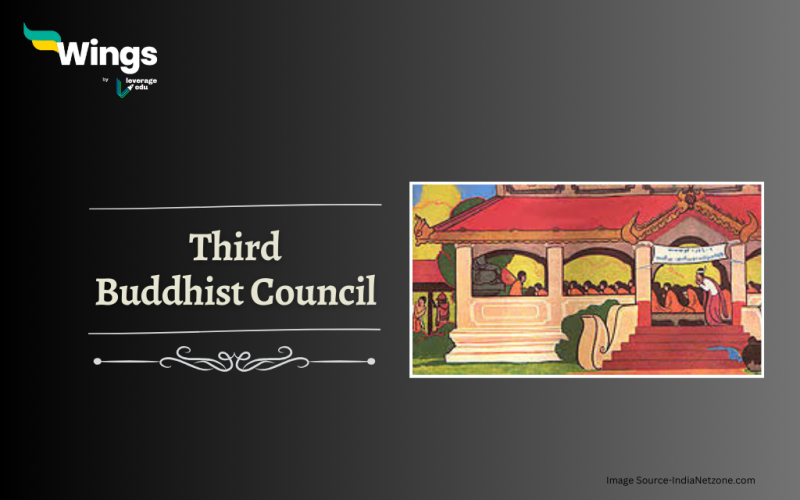The Third Buddhist Council was held about 236 years after Buddha’s mahaparinirvana. It was held under the royal patronage of Emperor Ashoka, the Great at Ashokarama in Patliputra (Modern-Day Patna), the capital of the Mauryan Empire. The Buddhist Council aimed to reconcile the differences that had emerged within the monastic community which was divulged into 18 small sects, each with different doctrines, Dhamma and Vinaya, claiming to be given by Buddha. They were non-Theravadan practices. Thus, when Ashoka came to know of such practices, the third council took place to reiterate the Dhammas again and eventually preserve the teachings of the Gautama Buddha. It was a crucial gathering of scholars and monks who came together to discuss and codify the Buddhist scriptures. Do scroll down to learn more about the Third Buddhist Council.
Table of Contents
People Involved in the Third Buddhist Council
The Third Buddhist Council was attended by nearly 1,000 monks, including:
- Emperor Ashoka: As the patron of the Third Buddhist Council, Emperor Ashoka, played an important role in convening the council and ensuring its success. During his rule, he helped spread Buddhism across the Indian subcontinent and beyond. He even built many stupas and his edicts show Buddhist scriptures.
- Venerable Thera Moggaliputta Tissa: He was called on the special invite and was personally received by Ashoka himself. Venerable Thera Moggaliputta Tissa presided over the council and provided guidance to the assembled monks. His knowledge of Buddhist scriptures as an orthodox Theravada monk was respected and admired amongst his peers.
Also Read – Buddhist Education System: Features, Role & Merits
Reasons for the Third Buddhist Council
The main objective of the council was to eliminate the bogus and corrupted monks from the Sanha. Here are some more reasons why the Third Buddhist Council was conducted –
- Standardization of Buddhist Teachings: One of the primary goals of the Third Buddhist Council was to preserve the teachings of the Buddha and guarantee their accurate transmission to future generations. The council also compiled the Tripitaka, the sacred scriptures of Buddhism, which consist of the Vinaya Pitaka, Sutta Pitaka, and Abhidhamma Pitaka.
In Kathavatthu (Abhidhamma Pitaka), Venerable Thera Moggaliputta Tissa refuted the heretical teachings and put an end to all the prevalent unorthodox views.
- Elimination of Heresies: Another important reason to conduct the council was to address any deviations from orthodox Buddhist doctrine and to refute heretical views that had emerged within the sangha. By establishing a clear set of guidelines and principles, the council sought to maintain the purity of the Buddha’s teachings. The views that were refuted were –
- Dissent in Schools – In this they refuted and discussed matters over the non-Theravadan view consisting in the other 18 schools that included Mahasangikas, Mahisassakas, Kassapikas, Sarvastivadins, Vajjiputakas, Sammityas, etc.
- Pali Canonical Order – The monks discussed nearly 23 books, which had topics like knowledge; doubt of Arhants, present, past and future, salvation, cessation, emancipation, mental consciousness, etc
- Subject of Discourse – Under this, controversies surrounding Buddha were discussed, like – Worlding, Religion, Devas, Order, Cosmology, Individuals, ethics and unconditioned points, Ariyans, etc.
- Propagation of Buddhism: The Third Buddhist Council also focused on the propagation of Buddhism to various regions across Asia. The council members were tasked with disseminating the Dhamma and Vinaya to both monastic communities and lay followers, thereby expanding the reach of the Buddha’s teachings.

Significance of the Third Buddhist Council
The Council’s most remarkable accomplishment was the dispatch of Buddhist monks to 9 different areas across India to propagate the religion. Teams of five monks were sent to nearby countries to spread the Dhamma. A group of five is capable of conducting most sanghakamma and ordination ceremonies.
The most notable significance was in the overseas missions in the following regions:
- Majjhantika Thera – Kashmir & Gandhara (North Punjab),
- Rakkhita Thera – Vanavasi (North Kanara),
- Mahadeva Thera – Mahisamandala (South of Vindhyan mountains),
- Yonaka Dhamma Rakkhita Thera – Aparantaka (North Gujarat, Kathiawar, Kacch & Sind),
- Mahadhamma Rakkhita Thera– Maharattha (Parts of the Marathi, modern Bombay),
- Maha Rakkhita Thera – Yonakaloka countries (clans of foreign race on NW frontier, Greeco-Bactrian kingdom),
- Majjhima Thera– Himavanta Padesa Bhaga (Himalayan region),
- Sona and Uttara Theras – Suvannabhumi (Lower Myanmar, Thailand, Java, and even Malaya)
- Mahinda Thera – Tambapannidipa (Sri Lanka).
The most critical and fruitful mission was to Sri Lanka which was led by King Ashoka‘s son, Ven. Mahinda, who converted the Sri Lankan king and eventually all of his subjects to Buddhism. The Tripitaka was also transported and compiled into writing in Sri Lanka about 300 years later.
Also Read – Sects of Buddhism: History, Origin, Branches
Outcomes of the Third Buddhist Council
The results of the council were –
- At the council, those who held incorrect beliefs about the Buddha’s teachings were exposed and immediately expelled from the Sangha.
- During this council, the final version of the Tripitakas was completed, which consisted of the Sutta Pitaka, the Vinaya Pitaka, and the Abhidhamma Pitaka, which dealt with the Buddha’s philosophy. All three were written in the Pali language.
- Thera Moggalliputta Tissa composed the Kathavattu, in which he aimed to disprove the wrong opinions and theories of several sects. The teachings and philosophy approved by this council are now known as Theravada.
- As part of the Dhamma Mission, Thera monks who were well-versed in the Buddha’s Dhamma and Vinaya were sent by Ashoka to nine different countries to spread the Dhamma. Their missions were successful and had an impact on civilizations and cultures.
That’s all about the Third Buddhist Council. If you want to read more articles like this, you can get Study notes on the Modern History of India here. Also, you can visit our general knowledge page on Indian History!
 One app for all your study abroad needs
One app for all your study abroad needs













